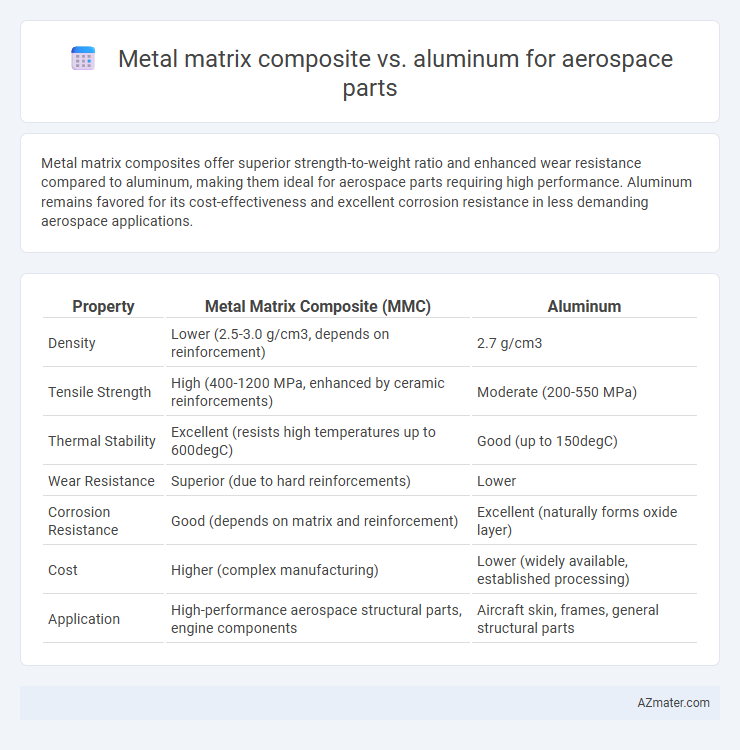Metal matrix composites offer superior strength-to-weight ratio and enhanced wear resistance compared to aluminum, making them ideal for aerospace parts requiring high performance. Aluminum remains favored for its cost-effectiveness and excellent corrosion resistance in less demanding aerospace applications.
Table of Comparison
| Property | Metal Matrix Composite (MMC) | Aluminum |
|---|---|---|
| Density | Lower (2.5-3.0 g/cm3, depends on reinforcement) | 2.7 g/cm3 |
| Tensile Strength | High (400-1200 MPa, enhanced by ceramic reinforcements) | Moderate (200-550 MPa) |
| Thermal Stability | Excellent (resists high temperatures up to 600degC) | Good (up to 150degC) |
| Wear Resistance | Superior (due to hard reinforcements) | Lower |
| Corrosion Resistance | Good (depends on matrix and reinforcement) | Excellent (naturally forms oxide layer) |
| Cost | Higher (complex manufacturing) | Lower (widely available, established processing) |
| Application | High-performance aerospace structural parts, engine components | Aircraft skin, frames, general structural parts |
Introduction to Aerospace Materials
Metal matrix composites (MMCs) offer superior strength-to-weight ratios, enhanced wear resistance, and improved thermal stability compared to traditional aluminum alloys in aerospace applications. Aluminum remains popular due to its lightweight nature, corrosion resistance, and ease of fabrication, but MMCs provide enhanced mechanical properties crucial for high-performance aerospace parts subjected to extreme operating conditions. The selection between MMCs and aluminum hinges on balancing factors such as cost, weight savings, durability, and specific mission requirements within aerospace material design.
Overview of Metal Matrix Composites (MMCs)
Metal Matrix Composites (MMCs) consist of a metallic matrix reinforced with ceramic or metallic fibers, enhancing mechanical properties such as strength, stiffness, and thermal resistance compared to conventional aluminum alloys. In aerospace applications, MMCs offer superior performance by providing higher specific strength and improved wear resistance under extreme conditions. The tailored microstructure of MMCs enables better fatigue life and dimensional stability, making them ideal for critical aerospace components where aluminum may fall short.
Properties of Aerospace-Grade Aluminum
Aerospace-grade aluminum alloys, such as 7075 and 2024, offer a high strength-to-weight ratio, excellent corrosion resistance, and good fatigue performance, making them ideal for lightweight aircraft structures. These alloys demonstrate superior machinability and weldability compared to many metal matrix composites (MMCs), supporting complex manufacturing processes in aerospace applications. While MMCs provide enhanced stiffness and thermal stability, aerospace aluminum remains favored for its balanced mechanical properties, cost-effectiveness, and proven reliability in critical aircraft components.
Strength and Weight Comparison: MMCs vs Aluminum
Metal matrix composites (MMCs) offer superior strength-to-weight ratios compared to aluminum alloys, making them ideal for aerospace components requiring enhanced mechanical performance and reduced weight. MMCs combine a lightweight metal matrix, often aluminum or titanium, with ceramic reinforcements like silicon carbide, significantly increasing tensile strength, stiffness, and wear resistance while maintaining low density. Aluminum remains popular due to its cost-effectiveness and ease of manufacturing, but MMCs provide exceptional performance advantages in critical aerospace applications where structural integrity and weight reduction directly impact fuel efficiency and payload capacity.
Thermal Performance in Aerospace Applications
Metal matrix composites (MMCs) exhibit superior thermal performance compared to aluminum in aerospace applications due to their enhanced thermal conductivity and resistance to thermal expansion. MMCs like aluminum reinforced with silicon carbide particles offer improved heat dissipation and dimensional stability under high-temperature conditions typical in aerospace environments. These thermal advantages contribute to better performance and longevity of critical aerospace components exposed to extreme temperature variations.
Fatigue and Corrosion Resistance
Metal matrix composites (MMCs) offer superior fatigue resistance compared to aluminum alloys due to their enhanced load-bearing capacity and crack propagation resistance, making them ideal for high-stress aerospace components. MMCs also exhibit significantly improved corrosion resistance, as the ceramic reinforcements within the metal matrix reduce susceptibility to environmental degradation. Aluminum, while lightweight and cost-effective, typically requires coatings or treatments to match the corrosion and fatigue performance of MMCs in aerospace applications.
Manufacturing and Fabrication Processes
Metal matrix composites (MMCs) offer superior strength-to-weight ratios and wear resistance compared to aluminum, making them ideal for aerospace parts subjected to high stress and temperature. Fabrication of MMCs typically involves advanced processes such as powder metallurgy, stir casting, or squeeze casting, which provide enhanced microstructural control but require more complex equipment and higher costs than conventional aluminum alloy fabrication. Aluminum parts benefit from well-established manufacturing techniques like rolling, extrusion, and machining, offering ease of fabrication and cost-effectiveness, though with limited performance in extreme aerospace environments.
Cost Analysis and Economic Considerations
Metal matrix composites (MMCs) offer superior strength-to-weight ratios and enhanced thermal resistance compared to aluminum, but their production costs are significantly higher due to complex manufacturing processes and expensive raw materials. Aluminum remains economically favorable for aerospace parts because of its widespread availability, ease of fabrication, and established recycling infrastructure, which reduces lifecycle costs. When selecting materials, aerospace manufacturers must balance MMCs' performance benefits against the substantial initial investment and potential economic return over a component's service life.
Application Case Studies in Aerospace
Metal matrix composites (MMCs) exhibit superior mechanical properties and thermal stability compared to aluminum, making them ideal for critical aerospace components such as turbine blades, brake discs, and airframe structures. Case studies demonstrate MMCs' enhanced wear resistance and reduced weight contribute to improved fuel efficiency and performance in high-stress environments. Aluminum alloys remain widely used in non-structural parts due to their excellent corrosion resistance and cost-effectiveness, but MMCs increasingly dominate applications demanding higher strength-to-weight ratios and temperature tolerance.
Future Trends: Advancements in MMCs and Aluminum
Metal matrix composites (MMCs) are expected to dominate future aerospace applications due to their superior strength-to-weight ratio, enhanced thermal stability, and improved fatigue resistance compared to traditional aluminum alloys. Innovations in nano-reinforcement and additive manufacturing techniques are accelerating the development of MMCs with tailored properties, enabling complex geometries and improved performance in extreme environments. While aluminum continues to evolve through advanced alloy formulations and heat treatments for cost-effective lightweighting, MMCs offer unparalleled design flexibility and durability critical for next-generation aerospace parts.

Infographic: Metal matrix composite vs Aluminum for Aerospace part
 azmater.com
azmater.com